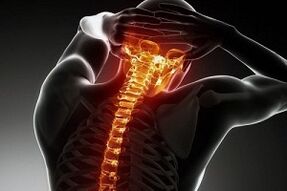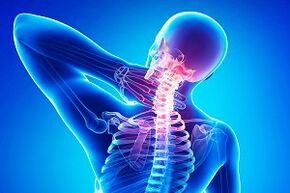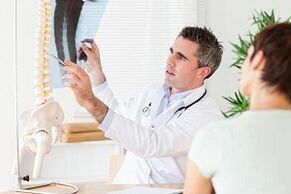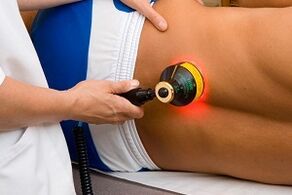
Osteochondrosis is a spinal disorder that millions of people of all ages face.
Degenerative and dystrophic changes in the intervertebral discs, the proliferation of osteophytes cause pain syndrome, reduce the mobility of the supporting column. Symptoms depend on the affected area.
In most cases, negative manifestations affect not only the supporting pillar and the paravertebral zone, but also spread to other areas.
In the absence of treatment, the disease progresses, the work of organs and systems is disrupted, the state of health worsens noticeably, constant pain and complications against the background of pathology can lead to disability.
It is important to know what osteochondrosis is, the causes of a common disease, methods of treatment and prevention.
The reasons for the development of the disease

Degenerative and dystrophic processes in the intervertebral discs, excessive ossification in the affected area develops in the following cases:
- back injuries;
- high loads on the support pole during hard work, professional sports, carrying loads;
- congenital defects of the supporting column;
- deficiency of vitamins, minerals, deterioration of the quality of the pillow;
- violation of mineral metabolism;
- hormonal disorders, endocrine diseases;
- lack of movement, sedentary work;
- severe obesity;
- a decrease in the elasticity of the intervertebral discs in the elderly, with aging of the body;
- excessive consumption of strong coffee, carbonated and alcoholic drinks, acidic foods, smoked meats, smoking;
- tumor process in the paravertebral area, causing damage to the elastic structures of the spine.
Types and stages
Osteochondrosis affects all parts of the supporting column. Degenerative processes are most actively manifested in the mobile regions: the lumbar and cervical area, in the thoracic area, damage to the vertebrae, bone tissue is less common.
Depending on the affected area, there are different types of osteochondrosis:
- cervical;
- Strongbox;
- lumbosacral.
Stages of the pathology:
- First stage- the development of chondrosis. Lack of nutrients impairs the quality of the disc and the elasticity of the cushion cushion decreases. High loads against the background of thinning cartilage tissue cause mild to moderate pain in the spine;
- second phase.Deformations of elastic structures are more pronounced, pain appears not only during loads, but also when bending, turning. The defeat of the fibrous ring leads to pinching of sensitive structures, increased friction of bone elements;
- third stage.The integrity of the fibrous ring is broken, the disc protrudes beyond the vertebra, the pain syndrome is pronounced. It is difficult for the patient to do without drugs that reduce discomfort. Against the background of the destruction of the elastic pad, the mobility of the supporting column decreases, protrusions and intervertebral hernias develop;
- fourth stage.The cartilage layer is practically absent, osteophytes appear on the spine. Bone growths are an attempt to compensate for the excessive load on the affected vertebrae. Dense elements stabilize the spine, but at the same time reduce the mobility of the problem area of the supporting column. At the fourth stage of osteochondrosis, the pain subsides, but the patient has difficulty performing simple movements. If changes occur in the lumbosacral area, lower body paresis or paralysis may occur. Often, in the fourth stage of osteochondrosis, the patient develops a disability.
On a note!Supportive spine disease occurs with periods of remission (from several months to a year or more) and exacerbations (the duration of relapse, the strength of pain depends on many factors).
First signs and symptoms

The manifestation of the disease depends on the stage and the affected section.
The more negative factors, the greater the risk of pain syndrome, damage to other areas.
Blood circulation deteriorates, mineral metabolism is impaired, protrusions develop, vertebral hernias, excessive ossification appears in the affected area.
Self-medication, lack of qualified care, combined with a reluctance to periodically visit a vertebrologist, adversely affects the state of the vertebral structures.
Cervical
The main signs are:
- radicular syndrome with severe disc damage;
- pain in the back of the head, neck, crown;
- dizziness, fainting;
- headache;
- discomfort in the muscles of the shoulders, neck;
- numbness of the cervical area, hands, fingers;
- discomfort in the chest area;
- reduced mobility of the cervical spine;
- decreased or loss of shoulder muscle reflexes;
- feeling of "goosebumps" in the hands, fingers;
- with osteochondrosis of the cervical spine, a person is tormented by insomnia, depressive conditions, irritability against the background of stabbing or aching pains in the neck and head.
Thoracic osteochondrosis
Typical signs:
- with a long stay in one position, heavy loads, bends, bends, chest pain appear;
- with a deep breath, discomfort of varying intensity is felt in the central part of the back;
- when raising the arms, the body moves, the pain increases;
- with the progression of osteochondrosis of the thoracic region, problems appear in the work of the digestive tract;
- in the hands there is an unpleasant feeling of "goosebumps";
- depending on the degree of damage, doctors distinguish back pain - aching painful sensations in the affected spine and back - sharp, stabbing pains of high intensity, constriction of breathing, which cause muscle spasms;
- intercostal neuralgia develops;
- aching or sharp pain in the shoulder blade area;
- reproductive disorders occur.
lumbosacral region

The main symptoms are:
- discomfort of varying intensity in the lower back;
- muscle weakness, development of paresis;
- cold and numbness of the lower limbs;
- pain syndrome is pronounced with heavy loads or lifting of loads;
- painful low back pain appears: the pain radiates from the lower back to the gluteal area, groin, legs;
- intermittent claudication develops;
- compression of the nerves adversely affects the work of the pelvic organs: with a severe degree of lumbosacral osteochondrosis, urinary incontinence, involuntary defecation is possible;
- fatigue appears, it is difficult to stand, long walking causes weakness in the legs.
Diagnostics
To clarify the condition of the spine, it is necessary to contact a vertebrologist. In the absence of a doctor of this specialization, it is necessary to visit a neurologist or orthopedic traumatologist.
Diagnostic measures:
- Examination of the patient, examination of complaints.
- magnetic resonance.
- CT.
- X-ray of the spine in different projections.
- Doppler ultrasound of blood vessels.
- Electromyography.
Effective treatments
How to treat osteochondrosis? Chronic pathology requires attention from both the doctor and the patient. Do not expect negative symptoms to disappear a week after starting the course of therapy. Only an integrated approach gives results. The patient must understand that drugs alone cannot eliminate degenerative-dystrophic changes in the discs, prevent the proliferation of osteophytes.

For the successful treatment and prevention of osteochondrosis, it is important:
- perform a physical therapy complex;
- attend massages and physiotherapy;
- Healthy food;
- organize a workplace and sleep, taking into account the recommendations of a doctor;
- do not lift weights;
- periodically take vitamins, mineral complexes to maintain the elasticity of the discs, the strength of bone tissue;
- refuse too intense workouts;
- avoid back injuries and bruises;
- check your weight
There are other important rules:
- do not overcool;
- treat pathologies that negatively affect the condition of the discs;
- take breaks, warm up while working on the computer;
- move more, do physical education;
- give up excessive consumption of coffee and alcohol, forget about smoking;
- avoid prolonged static / dynamic loads;
- sleep on an orthopedic mattress and a low pillow;
- less nervous;
- reserve at least 7 hours for a night's sleep;
- periodically visit a vertebrologist, monitor the condition of the vertebral structures.
medications
Effective groups and names:
- chondroprotector. . . They restore cartilage tissue, slow down the process of disc destruction. Course - 4 months or more;
- NSAIDs. . . Medicines relieve pain, eliminate swelling and inflammation. Local remedies give a good effect: ointments, gels, plasters;
- B vitamins. . . The drugs restore nerve regulation, improve the nutrition of neurons and reduce the strength of the pain syndrome. Injections (the first days, during an exacerbation) and tablets (for a long course of treatment and prevention) are effective;
- muscle relaxants. . . Means cope with muscle spasms, which are the main cause of pinching of nerve endings;
- compositions that normalize blood circulation.Most often, drugs of this group are prescribed for cervical osteochondrosis, against which the brain suffers;
- spinal blocks, injection into the paravertebral area. This type of exposure helps with excruciating low back pain and pain against the background of pinched nerves in the third or fourth stage of osteochondrosis. Corticosteroids and excipients are added to analgesics to increase their effect;
- drugs of the GCS group.Steroid formulations are essential for severe pain. Often, injections are prescribed for lumbosacral osteochondrosis, against the background of which painful low back pain develops.
Exercise and gymnastics
Exercises for the cervical, lumbosacral and thoracic regions are prescribed after the relief of acute pain, the attenuation of the inflammatory process. For each zone, doctors developed a physical therapy complex with varying degrees of stress.
The first sessions are conducted under the guidance of a physiotherapist. After studying the complex, the patient continues to train at home. It is important to observe the duration and frequency of the sessions to obtain the therapeutic effect. In addition to physical education, vertebrologists recommend going to the pool - swimming is an ideal type of positive effect on the spine.
Physiotherapy procedures

Effective methods of influence:
- applications of ozokerite;
- laser therapy;
- radon and turpentine baths;
- shock wave therapy;
- electrical procedures;
- mud therapy;
- phonophoresis and electrophoresis with drugs;
- magnetotherapy.
The following methods give a good effect in the treatment of osteochondrosis:
- acupuncture;
- hirudotherapy;
- reflexology;
- using a needle applicator;
- manual therapy;
- dry and underwater traction of the spine;
- medical hippo.
It is quite difficult to prevent the development of osteochondrosis, but doctors recommend remembering the factors that cause dystrophic and degenerative processes in the vertebral structures. The more attention a person pays to a healthy lifestyle, the lower the risk of developing negative changes in the intervertebral discs.

















































